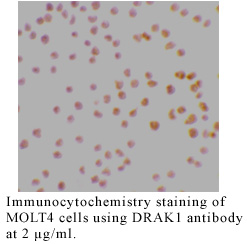Anti-Human DRAK1 (NT)
| Code | Size | Price |
|---|
| LEI-D257-20ug | 20 ug | £199.00 |
Quantity:
| LEI-D257-0.1mg | 0.1 mg | £591.00 |
Quantity:
Prices exclude any Taxes / VAT
Overview
Host Type: Rabbit
Antibody Clonality: Polyclonal
Regulatory Status: RUO
Target Species: Human
Applications:
- Immunohistochemistry- Paraffin Embedded (IHC-P)
- Western Blot (WB)
Shipping:
Ambient
Storage:
This polyclonal antibody is stable for at least one week when stored at 2-8°C. For long term storage aliquot in working volumes without diluting and store at -20°C in a manual defrost freezer. Avoid Repeated Freeze Thaw Cycles.
Images
Further Information
Concentration:
0.5 mg/ml
Conjugate/Tag/Label:
Purified No Carrier Protein
Format:
This polyclonal antibody is formulated in phosphate buffered saline (PBS) pH 7.4 containing 0.02% sodium azide as a preservative.
Formulation:
This polyclonal antibody is formulated in phosphate buffered saline (PBS) pH 7.4 containing 0.02% sodium azide as a preservative.
Immunogen:
PN:D281
Long Description:
Apoptosis is mediated by death domain containing adapter molecules and a caspase family of proteases. Certain serine/threonine protein kinases, such as ASK-1 and RIP, are mediators of apoptosis. Two novel serine/threonine kinases that induce apoptosis were recently identified and designated DRAK1 and DRAK2 for DAP kinase-related apoptosis-inducing protein kinases.1 DRAKs contain an N-terminal kinase domain and a C-terminal regulation domain. Overexpression of DRAK1 induces apoptosis. DRAKs have high sequence homology to DAP and ZIP kinases, and they represent a novel family of serine/threonine kinases, which mediates apoptosis through their catalytic activities. DRAK1 is located in nucleus and the messenger RNA was ubiquitously expressed in human tissues.1
Target:
DRAK1
References
1. Sanjo, H. et al. (1998) J Biol Chem 273:29066-71.
Related Products
| Product Name | Product Code | Supplier | DRAK1 (NT) Blocking Peptide | LEI-D281 | Leinco Technologies | Summary Details | |||||||||||||||||||||||||||||||||||||||||||||||||||||||||||||||||||||||||||||||||||||||||||||
|---|---|---|---|---|---|---|---|---|---|---|---|---|---|---|---|---|---|---|---|---|---|---|---|---|---|---|---|---|---|---|---|---|---|---|---|---|---|---|---|---|---|---|---|---|---|---|---|---|---|---|---|---|---|---|---|---|---|---|---|---|---|---|---|---|---|---|---|---|---|---|---|---|---|---|---|---|---|---|---|---|---|---|---|---|---|---|---|---|---|---|---|---|---|---|---|---|---|---|---|



